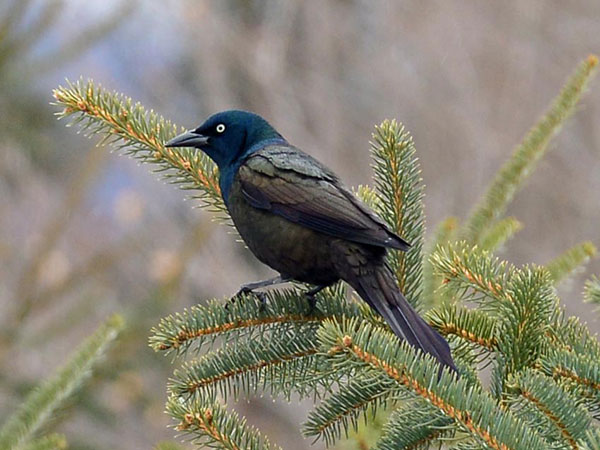Bird-be-gone: hazing in theory and practice

Canada geese and goslings on Moreau Lake. NCPR photo of the day by Susan Dornan, Ft. Edward NY.
Here’s a little “local” Ottawa story that even showed up Tuesday on NPR as a quick/funny news bit: fed up by hungry Canada geese causing vexing losses to important test crops at the Central Experimental Farm, a border collie patrol was brought in to “haze” the offending birds away.
NPR’s initial story referred to the opportunistic gobblers as “Canadian geese”. That slip forced a next-day correction. Like ’em or hate ’em, it’s “Canada geese” folks.
There’s more on that from the Ottawa Citizen’s Tom Spears, including photos and a video on the tag team of Jamie and Bella:
They don’t charge blindly at geese and yap at them. Border collies are natural sheep-herding dogs that put their heads down like a stalking wolf and stare like Clint Eastwood in a bad mood. Then they move forward in a deliberate, menacing way.
It seems to work. From an estimated 1,500 geese a few weeks ago, the Farm was down to just two on Wednesday morning
NPR said the contract for this dog-patrol service came in at $44,000 per year. (UPI said it was $43,000.) Yes, we all know people with dogs who would do that for free. But there’s real work involved and a degree of skill and expertise too. The dogs need to patrol several times a day (in the spring at least) and behave in a way that “trains” the geese to go loiter somewhere else. The Central Experimental Farm estimates losses for last year alone at $250,000 (much of that on new crop lines that take time to develop or replace).

A view of cereal research plots for the Eastern Cereal and Oilseed Research Centre. (photo from Agriculture and Agri-food Canada)
Gareth Williams and Heather Williams run Border Control Goose Dogs, in Stirling, Ontario, and reportedly hold the current contract with the Experimental Farm. Judging by their website, they’ve rendered services from Long Island to Arizona and points in between. The Citizen article including this funny-if-it-happens-to-someone-else observation from Gareth:
One last pointer on Canada geese. In about two weeks they will moult, losing their main flight feathers. “So whoever has them then will be stuck with them for about six weeks,” Williams said.
He’s not sure where the Farm’s former geese have gone, “but somewhere there’s probably a golf course where my name is mud.”
It was interesting to read about the concept of hazing as a humane and ecological way to encourage birds to relocate. Birds don’t want to live or raise families where predators threaten, and the border collies know how to make geese feel like danger lurks, without actually harming anything.
When we lived in Kars, Ontario we had long cedar hedges around an above-ground pool – a combination much-favored by grackles. Grackles, as we came to discover, like to nest near bodies of water. They faithfully deposit all the poop from their hatchings into whatever natural toilet they can find. (Lacking a pool, decks, driveways and cars can also become attractive targets.) They carry the poop sac in their beak and fly it to preferred drop-off spots. I thought I was imagining the pattern at first, but no. It’s real. And makes for some disgusting situations. We spent over ten years trying to “haze” our resident grackle population into relocating.
I can’t gauge the intelligence of Canada geese. But grackles are diabolically smart, with excellent powers of observation and tremendous memory to boot. It takes them very little time to grasp that the bobble-headed owl does not fly, eats nothing and poses no threat. A ‘soundbox’ of bird distress calls (just like what vineyards use) worked – for about a week. They figured that out too – just so much noise that sounds bad, but signified no actual danger.
-

Common grackle. “Good to see the return of this much-maligned (with some reason), super-intelligent king of the backyard.” Photo of the day by Ed Murphy, Vermontville, NY
The most effective thing I tried was stringing nylon fishing line across the flight path to the pool. That presented an actual problem as the line is hard to see and not fun to hit. (Yay! A winner!) But it’s considerable work to tie the lines across a large expanse. Plus, after a while, you feel stupid having a booby-trapped yard and the up-keep of tuning the trip lines to stay above human head height. It becomes something of a Pyrrhic victory – just not worth the effort or the odd appearance.
The most fun we had with the problem was slingshot patrol. Several times a day each spring we’d grab a sling shot, a bunch of ammo and go (as I now know the term) hazing. Ammo was something of a head-scratcher at first. We required something plentiful that would not present a problem for neigbors, house windows, the yard or the lawn mower. We began with acorns, but with just one oak tree we always ran out. Mini-ice cubes were tried (they melt into nothing!) but it was a pain to keep the supply at hand and cold to handle.
Finally we settled on large dried lima beans, bought in bulk. (Biodegradable, don’t you know?) Lima beans are sort of flat and oval which causes them to wobble in flight — a good feature for this task. You pretty much could not actually hit the birds this way, even if you tried – which I figured kept things non-lethal and legal. Close was plenty good enough. It made them fly away and think of our yard as hostile territory.
Did I mention that grackles are smart? They always knew what was up. They even knew if you were armed or not. We never fully won, not really. There were too many of them and too few of us. Eventually we moved to a yard in North Gower, with no pool and a neighbor who likes to feed a family of crows. The crows drop by on a regular basis and are quite happy to cruise hedge tops for grackle nests for additional snacking material. Of course, too many crows are a whole separate issue, but so far only a few are involved.
Poop in the pool may be a mild version of a grackle problem. Here’s a story from USA Today on communities that struggle to deal with massive flocks, including Portales, New Mexico, where things got pretty serious:
After multiple deterrents were tried, the town finally found a labor-intensive method that has worked so far. Just at dusk, a half-dozen city workers hang tin buckets containing a string of 50 Black Cat firecrackers in the trees. Each tree has a staffer assigned to it, all with two-way radios. Then “we’d light them all at the same time,” DeSha said. “The sound and light and vibration, the shock waves, would drive the birds up in the air.” Several nights of this trains the birds to find somewhere else to roost. To avoid calls to police, his office did a “huge media blitz to let everybody know what we were doing,” he said.
Opinions vary on this topic. Some say live and let live, or recall that the critters were here first. That may well be, but even animals compete for territory and defend their own space.
Our previous village of Kars was surrounded by plenty of natural habitat for wildlife. That being the case, I’ll argue the quarrel wasn’t about basic survival. It was about prime territory. (Ours! So there!) Same story for woodpeckers: go drill a tree and stop turning our house into swiss cheese. (I am so glad we no longer live in a cedar-sided structure!) Sometimes defensive action seems necessary.
On the other hand, I am one of those gardeners who keeps a fresh, full birdbath and adds plants that attract butterflies and hummingbirds. Part of my back yard now is done in “natural meadow”. I welcome most wildlife – just not the trouble-making rowdies.
What’s your idea of a “pest” species you’d like to haze out of your space and have you found clever ways of doing so?
Tags: canada, Canada geese, Central Experimental Farm, grackles








Bottle rockets that screech and then pop are very effective. They rise fro fifty to eighty feet which puts them right at tree-top level when they pop. Fireworks are illegal here, so that makes it a bit more of a game.